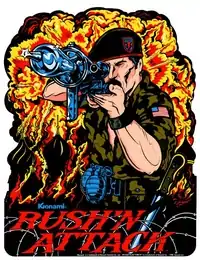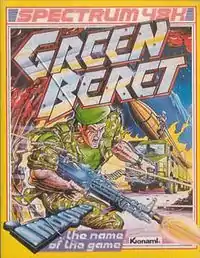Rush'n Attack
Rush'n Attack, originally released in Japan and Europe as Green Beret (グリーンベレー, Gurīn Berē), is a run and gun arcade game released by Konami in 1985.[2] Rush'n Attack is remembered for its Cold War setting (the title is a play on "Russian attack") and its reliance on the player using a knife to dispatch enemies.
| Rush'n Attack (a.k.a. Green Beret) | |
|---|---|
 North American arcade poster | |
| Developer(s) | Konami |
| Publisher(s) | Konami |
| Composer(s) | Kiyohiro Sada, Shinya Sakamoto, Iku Mizutani, Satoe Terashima, Masanori Adachi (NES)[1] |
| Platform(s) | Arcade, Nintendo Entertainment System, Family Computer Disk System, PlayChoice-10, ZX Spectrum, Commodore Plus/4, Commodore 64, Amstrad CPC, Atari 8-bit, BBC Micro, MSX, Thomson, Game Boy Advance, Nintendo DS, Xbox 360 (Xbox Live Arcade), Mobile phones |
| Release | 1985 |
| Genre(s) | Run and gun |
| Mode(s) | Up to 2 players, alternating turns |
Gameplay
The player takes on the role of a United States special operations soldier infiltrating an enemy military base in order to save multiple POWs from being executed by firing squad. There are four stages: a Marshalling Area, a Harbor, an Air Base and a Siberian Camp. The omnipresent knife can be supplemented with captured arms. By killing certain enemy soldiers, the player can obtain a three-shot flamethrower, a four-shot RPG, or a three-pack of hand grenades. At the end of each stage, the player will face a unique group of enemies specific to that stage: Stage 1 ends with a truckload of running and jump kicking soldiers, Stage 2 with a pack of fierce dogs, Stage 3 with three shooting autogyros and Stage 4 with a skillful multi-shot flamethrower operator. When the mission is accomplished the four rescued POWs salute and the player repeats the game from the first stage on the next difficulty level. While the player can remain still in one area and rack up points, if he takes too long to proceed, the game will start sending out tougher enemies and eventually a stealth-like bomber will appear to take out the player. There's also an invisible time limit that will kill off the player if he takes too long to complete the stage.
Extra lives are given at 30,000 & 70,000, and per 70,000 up to 980,000, and "survival of the fittest" mode thereafter.
The in-game music is a looping drum cadence.
Home versions
Home computers

Under license from Konami, Imagine Software released home versions of the game under the Green Beret title for various home computer formats in Europe in 1986. Versions were released for the ZX Spectrum, Commodore Plus/4, Commodore 64, Amstrad CPC, Atari 8-bit, the MSX, and the BBC Micro. The Commodore 64 version was well known for its loading music by Martin Galway.
In 1987, the game was included on the compilation Konami Coin-op Hits with Hyper Sports, Mikie and Yie Ar Kung-Fu.[3] An unrelated IBM PC port was released by Konami for the North American market under the Rush'n Attack name in 1989.
NES/Famicom
A Family Computer Disk System version of Green Beret was released in Japan on April 10, 1987, along with a corresponding version for the Nintendo Entertainment System (under the Rush'n Attack name) released during the same month in North America and Europe.
The player's objective in the NES version was changed from rescuing prisoners to destroying a secret weapon being developed in the enemy's headquarters. Additionally, a 2-players co-operative mode was introduced as well, allowing two players to play simultaneously (with Player 1 in blue and Player 2 in red). The play mechanics are essentially identical to the arcade version, however the Flamethrower is removed (only the Rocket Launcher and Grenades remained) and two new power-up items are introduced: a Star mark which grants invincibility and a pistol with unlimited ammo, both which are only usable for a limited period. The NES version also features two additional stages that were not in the arcade game: an airport set between the Missile Base and the Harbor, where the player faces a group of rocket soldiers at the end; and a new final stage set inside the enemy's base in which the player must disarm a nuclear missile at the end that is about to be launched; by using rocket launchers dropped by enemy soldiers. The flamethrower corps at the end of the Warehouse stage was replaced by a paratrooper unit.
The Famicom version features a few differences from its NES counterpart by allowing the player to continue up to three times after a game over and if the player loses a life in the Famicom version, his character will respawn at the very spot where he died instead of being sent to the last checkpoint (in the NES version, instant respawns are only allowed in the 2-Players game). Moreover, the player can carry up to nine rounds of any secondary weapon he finds instead of just three. To rebalance the difficulty, the NES version gives the player more extra lives when they begin (four instead of two) and all weapons dropped by enemies will always have three rounds in them instead of having the player accumulate them one by one. The Famicom version also features hidden underground areas which the player could access by destroying certain land mines in Stage 2, 4, and 5.
Game Boy Advance
An arranged port of the arcade version of Rush'n Attack is included in the 2002 compilation Konami Collector's Series: Arcade Advanced for the Game Boy Advance. The game features the same stages as in the arcade version, as well as two extra stages accessible via the Konami Code that are based on the added stages from the NES version. A two-players versus mode is added which utilizes the Game Link Cable. The controls have been changed so that the player presses the A button to jump instead of Up on the d-pad.
Nintendo DS
A second portable is included in the 2007 compilation Konami Classics Series: Arcade Hits for the Nintendo DS. Unlike the GBA version, the DS version is a direct port of the original arcade game. However, it includes various bonus features such scans of the instruction cards and leaflet, as well as tips.
Xbox 360
Rush'n Attack was released as an Xbox Live Arcade title for the Xbox 360 on May 23, 2007. This version is another direct port of the arcade game, but features an optional game mode with improved graphics and a remixed soundtrack. This version was developed by Digital Eclipse.
Konami Net DX
Green Beret was released as an i-appli for Mobile phones in Japan in 2006. The mobile version is a direct port of the Famicom version with a new feature: the health bar. The mobile port was re-released in China for normal Java mobile phones on December 26, 2008.
Reception
| Publication | Score |
|---|---|
| Crash | 88%[4] |
| CVG | 34/40[5] |
| Sinclair User | |
| Your Sinclair | 9/10[7] |
| ACE |
In Japan, Game Machine listed Rush'n Attack on their November 15, 1985 issue as being the third most-successful table arcade unit of the year.[9]
Rush'n Attack/Green Beret was well received. The MS-DOS version of Rush'n Attack was reviewed in 1989 in Dragon #142 by Patricia Hartley and Kirk Lesser in "The Role of Computers" column. The reviewers gave the game 31⁄2 out of 5 stars.[10] The NES version ranked 99 on IGN's top 100 NES games list.[11]
Related games
- M.I.A.: Missing in Action - A 1989 arcade game by Konami where the player controls a special forces operative who must rescue POWs in Vietnam. While not marketed as a sequel to Rush'n Attack, it has been compared to it due to its similar premise and gameplay.[12]
- The Vindicator! - An action game by Imagine Software released in Europe for the Commodore 64, Amstrad CPC and ZX Spectrum in 1988. Some reprints of the game were released under the title of The Vindicator! Green Beret II, although Konami had no involvement in this game.
- Rush'n Attack: Ex-Patriot - An official sequel to Rush'n Attack released as a digital download for the PlayStation 3 and Xbox 360 in 2011. Developed by Czech-based Vatra Games, who also worked on Silent Hill: Downpour.
References
- "Rush'n Attack". The International Arcade Museum. Retrieved 5 Oct 2013.
- http://www.worldofspectrum.org/showmag.cgi?mag=C+VG/Issue065/Pages/CVG06500065.jpg
- http://www.worldofspectrum.org/showmag.cgi?mag=Crash/Issue28/Pages/Crash2800118.jpg
- http://www.worldofspectrum.org/showmag.cgi?mag=C+VG/Issue056/Pages/CVG05600019.jpg
- http://www.worldofspectrum.org/showmag.cgi?mag=SinclairUser/Issue051/Pages/SinclairUser05100035.jpg
- "Green Beret". ysrnry.co.uk. Archived from the original on 2006-07-05. Retrieved 3 Sep 2015.
- http://www.worldofspectrum.org/showmag.cgi?mag=ACE/Issue26/Pages/ACE2600114.jpg
- "Game Machine's Best Hit Games 25 - テーブル型TVゲーム機 (Table Videos)". Game Machine (in Japanese). No. 272. Amusement Press, Inc. 15 November 1985. p. 21.
- Lesser, Hartley; Lesser, Patricia; Lesser, Kirk (February 1989). "The Role of Computers". Dragon (142): 42–51.
- "99. Rush'n Attack - Top 100 NES Games - IGN". ign.com. Retrieved 3 Sep 2015.
- "Arcade Action". Computer + Video Games. United Kingdom: Future Publishing. April 1989.
External links
- Rush'n Attack at the Killer List of Videogames
- Rush'n Attack at MobyGames
- Green Beret at SpectrumComputing.co.uk